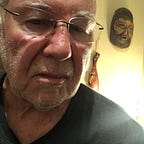A Simple Knee Pain Fix
Two trigger points you should learn how to release
You are walking or jogging, and suddenly you get a pain in your right kneecap. It hurts so much you can’t walk on it. You have your cell phone with you. “Honey? I’m down at the polo fields. Can you bring me some pain pills and a pair of crutches?”
Do you really want to do that? Of course not. You want to know where to push. To know that, you need to purchase a trigger point chart. There are wall charts and books easily available.
In bodywork, we use medial and lateral to say something is closer to the center of the body, medial, or toward the outside, lateral. When you look down at the knee, you are looking at your quads, the big muscles on the front of the leg. These four muscles are the great extensor of the knee. Here is an image. Note the vastus medialis (in red), which refers pain into the kneecap, and the vastus lateralis (in yellow), which refers pain into the back and sides of the knee.
The pain in the kneecap is most likely caused by the trigger point in the vastus medialis, the medial quad inside of the knee.
To relieve pain, press along in a line upward from the medial patella, and about six or eight inches up; if there is an active trigger point, you’ll hit it, and when you hit it, you’ll know it! There may be other pain points, but this one is the most painful, with a bright or hot sensation.
Now brace your knee in your right palm, put the thumb of the left hand into the trigger point, and press until the pain level is around 8, on a 1–10 scale. The idea is to press until the muscle begins to involuntarily tighten and then back off a little and hold the pressure. You have to keep relaxing the muscle while you press on it, which takes a little practice. You will feel a “jumping” as the muscle begins to let go.
When that happens, you’ll be ready to get back at it.
There is a trigger point for just about any muscular pain in the body, and while not all pain is muscular, that is the most likely issue because there are more than 600 skeletal muscles in your body. Only a couple hundred of them are on the trigger point chart, and of those, a few cause most of the trouble. This is one of them.
As we get older, it’s important to know how to take care of muscle pain without resorting to medication that only masks the pain but leaves the muscle up to 30% contracted. Technically the muscle goes “unconscious.”
Some trigger points you can release yourself, with a thumb or theracane, but you’ll want another person to learn these points with you, and you’ll need a good percussion massager with a bullet-headed attachment as well. It’s invaluable when it comes to avoiding too much stress on the thumbs.
A lot of them are junky so read some reviews.
When you have muscle pain, locate the trigger point by matching your pain referral pattern to one on the chart. Sometimes there are two or three possibilities. You find the point by pressing around the area corresponding to the point on the chart; if on a partner, ask her to give you feedback on the pain level, from 1–10. When you hit the point, she might say, “Twelve!”
You can use either thumb pressure or the percussion massager to release the point. You want to get constant feedback so that you don’t press too hard. If the person tightens the muscle, you have to back off until she can voluntarily relax the muscle. As the trigger point releases, it will feel to the other person exactly as if you are letting up the pressure.
Remember, if the pain is not in the kneecap but on the sides and back of the knee, you do the same thing on the outside of the leg, or the lateral quad, as you do on the medial quad, for kneecap pain.
With practice, you and your partner will be able to take care of most pain problems with the chart and the percussion point massager.
I will go through some of the most useful points as we move along with more self-care tips.
Disclaimer: This article contains affiliate links.
